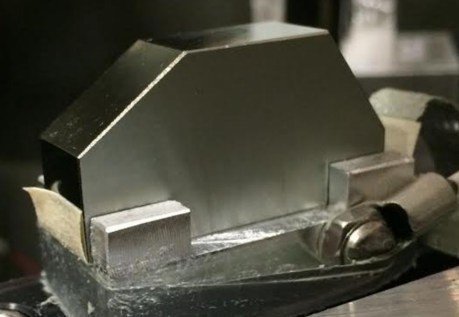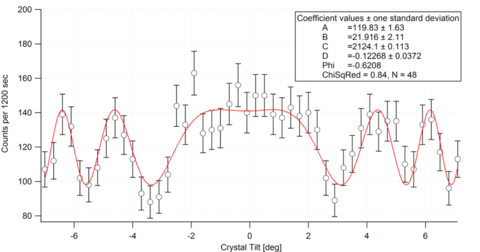Interferometry: Crystal Structure Factors Determined using Pendellösung Interference
Summary
Pendellösung interferometry can be used to measure the neutron’s interaction with a silicon lattice. This interaction is important in studying the dynamics of silicon bonds, the neutron itself, and for measuring weak forces. We have published the best measurements of this interaction using pendellösung interference for the (111), (220), and (400) reflections. We are continuing to explore this interact using high-order reflections in silicon and germanium.
Description

Figure 1: The germanium crystal target is shown. The flat surfaces along the top provide reference for the desired crystallographic orientations: (111), (220), and (400).
Crystal structure factors (FQ) describe the interaction of lattices with diffracting radiation. They include a scattering amplitude term, a correction for atomic thermal motion called the Debye-Waller factor, and are dependent on the momentum transfer Q = kinitial - kfinal. Tens of x-ray structure factors have been tabulated in silicon and germanium at temperatures ranging from 100 K to 300 K. Neutron structure factors contain equally valuable and complementary information, yet neutron structure factors have rarely been measured. Very few facilities in the world are capable of producing the proposed measurements, and none are as well-suited as the Neutron Interferometry and Optics Facility at the NCNR. A high-precision tabulation of x-ray and neutron structure factors would serve as a reference to researchers across multiple disciplines such as condensed matter, nuclear, and particle physics.
Further, neutron crystal structure factors contain an additional neutron-electron scattering term. This term is roughly 1/1000th the size of the largest contributing term which is due to the strong nuclear forces involved. Neutron-electron scattering is directly proportional to a quantity called the neutron charge radius through a series of known constants. The neutron charge radius relates to the spherically symmetric orientation of the quarks inside the neutron. Historically, the charge radius has been measured using the total transmission of neutrons through dense materials such as bismuth or lead. The difficulty of total transmission measurements is the systematic corrections of all the scattering effects. By measuring FQ we can obtain a charge radius result without large corrections and using an entirely new technique.
Undiscovered short-range forces can also manifest themselves in FQ measurements. Beyond the Standard Model short-ranged interactions can arise from theories with large extra spatial dimensions and modified gravity. They are parametrized by a strength αG and effective length scale λ5. Neutron structure factors can provide new limits in the range 0.01 nm ≤ λ5 ≤ 10 nm on these possible Beyond the Standard Model interactions.

The experiment uses a target of perfect silicon or germanium (see figure 1). Interference between the neutron currents traversing the crystal is called pendellösung interference. By measuring the phase of this interference (see figure 2) we can determine the structure factor of silicon. This experiment is performed at several different momentum transfers resulting in measurements of F400, F220, and F111. Here the subscript indexes (h k l) refer to the specific Bragg lattice vector being used. To eliminate the large nuclear scattering term and other systematics the overall phase of the target perfect silicon crystal is also measured inside a perfect-crystal neutron interferometer.
These measurements will provide important data for understanding nuclear structure, crystal dynamics, and Beyond the Standard Model physics.

